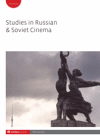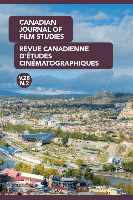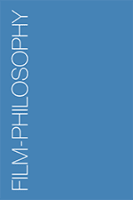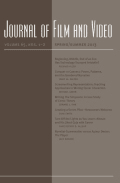
Studies in Russian and Soviet Cinema
Scope & Guideline
Celebrating the Intersection of Film, Culture, and History
Introduction
Aims and Scopes
- Historical Contextualization:
The journal frequently examines films within their historical frameworks, analyzing how cinema reflects and influences societal changes, political movements, and cultural shifts in Russia and the Soviet Union. - Cultural Identity and Representation:
It explores themes of national and cultural identity, particularly in relation to Ukrainian cinema and the representation of marginalized groups, including queer and Indigenous communities. - Interdisciplinary Approaches:
The journal incorporates various methodologies from film studies, cultural studies, history, and gender studies, fostering a comprehensive understanding of cinematic texts and their implications. - Critical Engagement with Film Theory:
Papers often engage with and critique established film theories, particularly in relation to Soviet cinema and its legacy, contributing to ongoing debates in the field. - Focus on Regional Cinemas:
There is a notable emphasis on the cinemas of Soviet peripheries and regional identities, which provides insight into less commonly explored aspects of Soviet film culture.
Trending and Emerging
- Queer Cinema and Gender Studies:
There is a notable increase in research addressing queer representation and gender identity within Russian cinema, indicating a growing interest in how these themes intersect with cultural and political discourses. - Post-Soviet Cultural Narratives:
Emerging themes related to post-Soviet identity, nostalgia, and socio-political critique are becoming central to discussions, highlighting how contemporary filmmakers engage with the legacies of the Soviet past. - Environmental and Cultural Contexts:
The exploration of environmental themes and their intersection with cultural identity, particularly in the context of regional films, is increasingly prominent, reflecting global concerns over ecology and identity. - Transnational Cinema:
Research is increasingly focusing on transnational collaborations and influences, particularly in the context of Cold War media and the global circulation of Soviet cinema, showcasing a more interconnected understanding of film studies. - Documentary Practices and Aesthetic Innovations:
There is a rising interest in documentary filmmaking practices within the Soviet context, particularly in how these films engage with historical narratives and contemporary issues, revealing new aesthetic dimensions.
Declining or Waning
- Traditional Soviet Cinema:
There appears to be a waning focus on classic Soviet films and directors, as newer research increasingly prioritizes contemporary cinema and newer narratives over historical analysis. - Conventional Gender Roles in Cinema:
Themes surrounding traditional portrayals of gender roles in Soviet cinema are becoming less prevalent, as the journal shifts towards more nuanced discussions of gender identities and queer representation. - Historical Film Adaptations:
While adaptations of classic Russian literature into film were previously a key focus, recent publications indicate a reduced emphasis on this topic, possibly in favor of original narratives that engage with contemporary issues.
Similar Journals

SIGHT AND SOUND
Celebrating the Artistry of Film and SoundSIGHT AND SOUND is a prestigious journal published by the British Film Institute, dedicated to the exploration of cinema and its cultural significance. With an ISSN of 0037-4806 and an E-ISSN matching the same, this journal has been a critical platform for film studies since its inception, contributing valuable insights to the realms of visual arts and performing arts. Despite its discontinuation in the Scopus database post-2021, SIGHT AND SOUND commands respect within its field, currently holding a Q3 rank among Visual Arts and Performing Arts journals. Operating from 21 Stephen Street, London W1P 1PL, England, it serves as a vital resource for researchers, professionals, and students looking to deepen their understanding of film theory, critique, and history. While access to its articles is not open, the journal continues to influence the discourse in film studies, making it a significant asset in academic and professional circles.

CINEJ Cinema Journal
Fostering Interdisciplinary Insights into Film.CINEJ Cinema Journal, published by the University of Pittsburgh Library System, stands as a pivotal platform for scholarly discourse in the dynamic field of cinema studies. With an ISSN of 2159-2411 and an E-ISSN of 2158-8724, this Open Access journal has been dedicated to disseminating high-quality research since its inception in 2011. CINEJ provides an essential resource for researchers, practitioners, and students alike, exploring varied dimensions of cinema, including its cultural, historical, and technological implications. The journal is committed to fostering interdisciplinary dialogue, making it a vital asset for those seeking to deepen their understanding of cinema as an art form and social phenomenon. By engaging with contemporary issues and trends in the cinematic landscape, CINEJ encourages contributions that illuminate the intersection of film and social inquiry, ensuring its relevance in today’s academic ecosystem.

French Screen Studies
Charting New Frontiers in Film and Media StudiesFrench Screen Studies is a distinguished journal published by Routledge Journals, Taylor & Francis Ltd, focusing on the dynamic interactions between film, media, and cultural studies within the context of French cinema. Since its inception in 2020, the journal has contributed significantly to the academic landscape, providing a platform for innovative research and critical discussion on visual arts and performance as reflected in its prestigious Q1 ranking in Visual Arts and Performing Arts for 2023. Despite being a burgeoning journal, it holds an impressive position within Scopus rankings, particularly in the Arts and Humanities sphere. Researchers and scholars will find the journal a vital resource, as it endeavors to explore the intersections of screen studies with broader social and cultural implications. Although currently not open access, French Screen Studies continues to foster an inclusive dialogue among academics, paving the way for future exploration of France’s influential cinematic heritage.

FILM QUARTERLY
Navigating the Landscape of Cinema and CultureFilm Quarterly, published by University of California Press, stands as a leading academic journal in the field of visual arts and performing arts, boasting a prestigious Q1 ranking in the 2023 category quartiles. Since its inception in 1969, this quarterly publication has made significant contributions to the study and critique of cinema, attracting attention for its insightful articles, cutting-edge research, and comprehensive reviews that appeal to scholars, practitioners, and students alike. With an ISSN of 0015-1386 and an E-ISSN of 1533-8630, it serves as an essential resource for those seeking to enhance their understanding of film theory, history, and analysis. Although not open access, its articles are critical for researchers navigating the complex landscape of contemporary and historical film studies, underscoring its vital role in advancing scholarship within the discipline.

Canadian Journal of Film Studies-Revue Canadienne d Etudes Cinematographiques
Exploring the Depths of Canadian CinemaCanadian Journal of Film Studies-Revue Canadienne d'Études Cinématographiques is a distinguished publication dedicated to the exploration of film studies within the context of Canadian cinema and global visual arts. Published by University of Toronto Press Inc., this journal offers a platform for innovative and critical scholarship, having achieved a notable Q2 ranking in the Visual Arts and Performing Arts category for 2023, with an impressive Scopus rank of 207 out of 667, positioning it in the 68th percentile among peers. With a continuous publication record since its established years from 1998 to 2001 and 2004 to 2024, it has become an essential resource for researchers, professionals, and students interested in the evolving landscape of film and cinema. The journal not only addresses theoretical perspectives but also engages with contemporary practices, thereby fostering a deeper understanding of cinematic arts. Despite not offering open access, it remains a vital repository of knowledge for those seeking to advance their studies and contribute to the discourse in film studies.

Cinemas d Amerique Latine
Illuminating the Cultural Landscape of Cinemas in Latin AmericaCinemas d Amerique Latine is a pivotal academic journal dedicated to the exploration and critical analysis of Latin American cinema. Published by PRESSES UNIV MIDI-PUM in France, this journal serves as an essential platform for scholars, practitioners, and students to engage with the diverse and dynamic landscape of visual storytelling throughout Latin America. With a dedicated focus on the cultural, historical, and aesthetic dimensions of film in this region, Cinemas d Amerique Latine aims to foster a deeper understanding of the cinematic narratives that shape and reflect Latin American societies. The journal has garnered a respectable Q3 ranking in the Visual Arts and Performing Arts category according to the latest 2023 evaluations, signifying its growing impact and relevance in the field. Despite its current lack of open access options, contributors can expect a rigorous peer-review process, ensuring the publication of high-quality research. Researchers exploring the rich tapestry of Latin American cinema will find Cinemas d Amerique Latine to be an invaluable resource in advancing their studies and contributing to vital scholarly conversations.

Film-Philosophy
Unveiling the Aesthetics of Cinema and PhilosophyFilm-Philosophy is an esteemed academic journal published by Edinburgh University Press, specializing in the intersection of film studies and philosophical discourse. Since its launch in 1998, this Open Access journal has provided a platform for scholarly debates and innovative research, allowing for free and unrestricted access to its content, which has significantly contributed to the global dialogue on visual culture. With a commendable impact illustrated by its Q1 ranking in Visual Arts and Performing Arts and Q2 in Philosophy, the journal sits within the top quartile of its field. Operating from the United Kingdom, Film-Philosophy is committed to fostering a multidisciplinary approach, inviting contributions from researchers, professionals, and students alike. By engaging with critical theories and the aesthetics of cinema, the journal stands as a vital resource for understanding the philosophical implications of film and its cultural significance.

JOURNAL OF FILM AND VIDEO
Advancing Conversations in Visual Media StudiesThe JOURNAL OF FILM AND VIDEO, published by University of Illinois Press, is a pivotal academic platform that delves into the intricate intersections of film, video, and media studies. With a notable ISSN of 0742-4671 and E-ISSN 1934-6018, this journal has established itself as a significant contributor to the visual arts and performing arts field, currently positioned in Q3 of its category as per the 2023 quartiles. Spanning from 2002 to 2024, it presents a comprehensive array of research, critiques, and theoretical discussions that advance scholarly discourse in film and video. The journal encourages contributions that explore innovative narratives and methodologies, catering to a diverse readership of researchers, professionals, and students alike. While it maintains a traditional subscription model and is not open access, its impact is amplified through its Scopus ranking, holding the 323rd position out of 667 in the visual arts and performing arts category. With its commitment to fostering critical conversations and promoting scholarly excellence, the JOURNAL OF FILM AND VIDEO remains an essential resource for those invested in the study and understanding of film and media.

Studies in Australasian Cinema
Engaging with the Evolution of Film Theory and CriticismStudies in Australasian Cinema is a premier scholarly journal published by ROUTLEDGE JOURNALS, TAYLOR & FRANCIS LTD, dedicated to the exploration of film and cinema within the Australasian context. With an ISSN of 1750-3175 and an E-ISSN of 1750-3183, this journal provides a vital platform for researchers, professionals, and students in the fields of Visual Arts and Performing Arts and Communication. Notably, it holds a prominent Q1 rank in Visual Arts and Performing Arts, reflecting its impact within the academic community. Although it is not an open access journal, its rigorous peer-review process ensures the highest quality of published research. Since its inception in 2007, Studies in Australasian Cinema has continued to contribute significantly to discourse surrounding film theory, criticism, and production, making it an essential read for anyone interested in the evolving landscape of Australasian cinema.

Etica & Cine
Exploring the Ethical Lens of CinemaEtica & Cine is a distinguished open-access journal published by the University of Buenos Aires, Faculty of Psychology, dedicated to the interdisciplinary field of ethics in cinema and visual culture. With the ISSN 2250-5660 and E-ISSN 2250-5415, this journal has been a vital platform for researchers, professionals, and students since its inception in 2011, providing a space for critical discourse surrounding the ethical dimensions of film and media. The journal aims to foster scholarly dialogue by publishing high-quality articles that explore the philosophical, social, and psychological implications of filmic representations. While the journal's H-index is yet to be established, its commitment to open access ensures that valuable insights are readily available to a global audience, thus enhancing its significance in academic and professional circles. As the conversation around ethics in cinema continues to evolve, Etica & Cine stands as an essential resource for anyone engaged in this vital area of study.